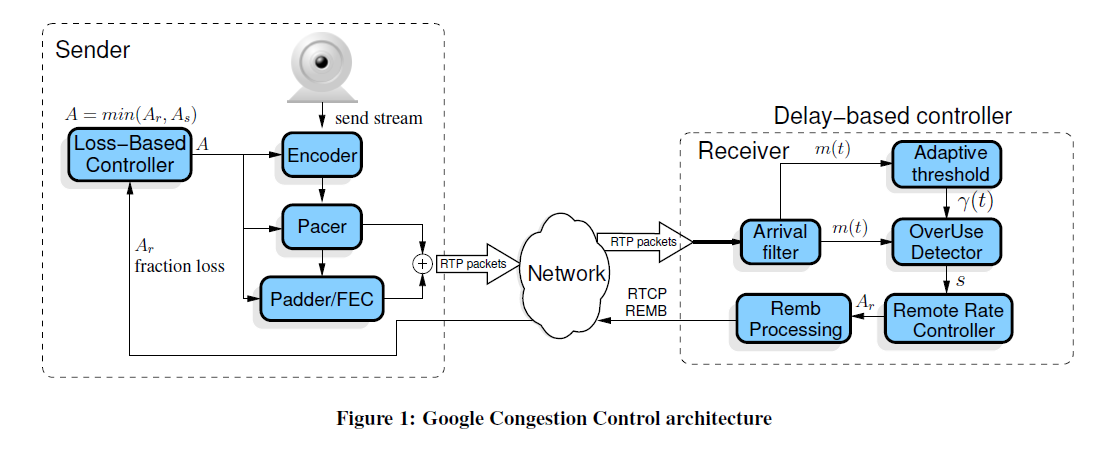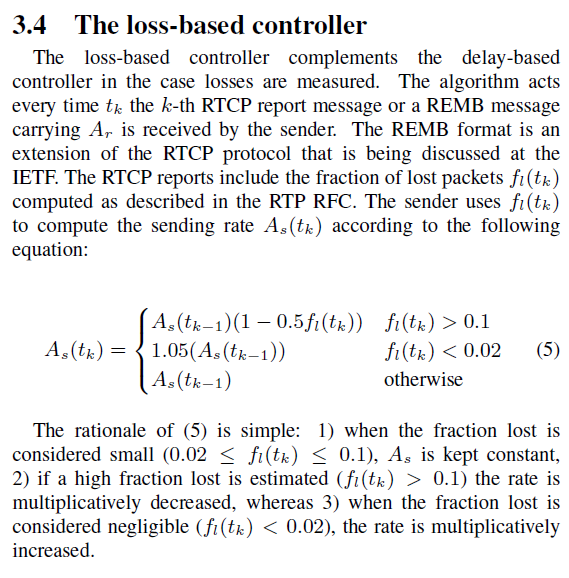webrtc中rtcp反馈与码率控制模块分析
0. 参考文档
1. 简介
webrtc的带宽估计分为两部分,一部分为发送端根据rtcp反馈信息进行反馈,另一部分为接收端根据收到的rtp数据进行相应的码率估计[1]。
本文先分析发送端根据rtcp反馈信息进行码率调整的部分代码。

具体计算公式:

2. 代码结构
2.1 类关系

rtp_stream_receiver中有一个继承自抽象类RtpRtcp的ModuleRtpRtcpImpl,ModuleRtpRtcpImpl中有一个rtcp_receiver。当有RTCP包到来时,逐层处理至rtcp_receiver,当包是rtcp receiver report包,则会将包解析,然后在ModuleRtpRtcpImpl中再次调用rtcp_receiver中的TriggerCallbacksFromRTCPPacket函数,触发对应rtcp的一些事件,反馈触发的主要是_cbRtcpBandwidthObserver的观察者(RtcpBandwidthObserverImpl),这个观察者收到对应的report block之后会计算成带宽估计所需要的参数,并调用属主bitratecontrolImpl类对带宽进行估计,这里会调用SendSideBandwidthEstimation中的UpdateReceiverBlock进行实际的带宽评估。
2.2 调用关系图

3. 代码分析
3.1 HandleReportBlock
这个函数中最主要的部分就是RTT的计算,webrtc中对于RTT平滑的因子是一个线性增长的因子。
/* 这个函数根据对应的report block生成了一个新的RTCPReportBlockInformation结构体,
* 并计算出对应的RTT,多report block在调用点处执行循环。 */
void RTCPReceiver::HandleReportBlock(
const RTCPUtility::RTCPPacket& rtcpPacket,
RTCPPacketInformation& rtcpPacketInformation,
uint32_t remoteSSRC)
EXCLUSIVE_LOCKS_REQUIRED(_criticalSectionRTCPReceiver) {
// This will be called once per report block in the RTCP packet.
// We filter out all report blocks that are not for us.
// Each packet has max 31 RR blocks.
//
// We can calc RTT if we send a send report and get a report block back.
// |rtcpPacket.ReportBlockItem.SSRC| is the SSRC identifier of the source to
// which the information in this reception report block pertains.
// Filter out all report blocks that are not for us.
if (registered_ssrcs_.find(rtcpPacket.ReportBlockItem.SSRC) ==
registered_ssrcs_.end()) {
// This block is not for us ignore it.
return;
}
RTCPReportBlockInformation* reportBlock =
CreateOrGetReportBlockInformation(remoteSSRC,
rtcpPacket.ReportBlockItem.SSRC);
if (reportBlock == NULL) {
LOG(LS_WARNING) << "Failed to CreateReportBlockInformation("
<< remoteSSRC << ")";
return;
}
// 用于RTCP超时的计算。
_lastReceivedRrMs = _clock->TimeInMilliseconds();
// 其他字段的拷贝。
const RTCPPacketReportBlockItem& rb = rtcpPacket.ReportBlockItem;
reportBlock->remoteReceiveBlock.remoteSSRC = remoteSSRC;
reportBlock->remoteReceiveBlock.sourceSSRC = rb.SSRC;
reportBlock->remoteReceiveBlock.fractionLost = rb.FractionLost;
reportBlock->remoteReceiveBlock.cumulativeLost =
rb.CumulativeNumOfPacketsLost;
if (rb.ExtendedHighestSequenceNumber >
reportBlock->remoteReceiveBlock.extendedHighSeqNum) {
// We have successfully delivered new RTP packets to the remote side after
// the last RR was sent from the remote side.
_lastIncreasedSequenceNumberMs = _lastReceivedRrMs;
}
reportBlock->remoteReceiveBlock.extendedHighSeqNum =
rb.ExtendedHighestSequenceNumber;
reportBlock->remoteReceiveBlock.jitter = rb.Jitter;
reportBlock->remoteReceiveBlock.delaySinceLastSR = rb.DelayLastSR;
reportBlock->remoteReceiveBlock.lastSR = rb.LastSR;
if (rtcpPacket.ReportBlockItem.Jitter > reportBlock->remoteMaxJitter) {
reportBlock->remoteMaxJitter = rtcpPacket.ReportBlockItem.Jitter;
}
int64_t rtt = 0;
uint32_t send_time = rtcpPacket.ReportBlockItem.LastSR;
// RFC3550, section 6.4.1, LSR field discription states:
// If no SR has been received yet, the field is set to zero.
// Receiver rtp_rtcp module is not expected to calculate rtt using
// Sender Reports even if it accidentally can.
if (!receiver_only_ && send_time != 0) {
// 当RR在SR之前发送,send_time为0.
// delay计算:
// Send SR Receive RR
// | delay in RR |
// | |<----------->| |
// |<---------------------->| |<----------------------->|
//
// RTT = total_time - delay_in_RR
// = receiver_rr_time - send_sr_time - delay_in_RR
// 即使中间几个SR丢包,但是如果RTT本身是平滑的,那么RTT不会受到这几个丢包的影响
// 因为SR->RR之间的delay可以精确计算。
uint32_t delay = rtcpPacket.ReportBlockItem.DelayLastSR;
// Local NTP time.
uint32_t receive_time = CompactNtp(NtpTime(*_clock));
// RTT in 1/(2^16) seconds.
uint32_t rtt_ntp = receive_time - delay - send_time;
// Convert to 1/1000 seconds (milliseconds).
rtt = CompactNtpRttToMs(rtt_ntp);
if (rtt > reportBlock->maxRTT) {
// Store max RTT.
reportBlock->maxRTT = rtt;
}
if (reportBlock->minRTT == 0) {
// First RTT.
reportBlock->minRTT = rtt;
} else if (rtt < reportBlock->minRTT) {
// Store min RTT.
reportBlock->minRTT = rtt;
}
// Store last RTT.
reportBlock->RTT = rtt;
// store average RTT
// RTT的平滑计算。
// 如果这个块是在CreateOrGetReportBlockInformation新生成的,
// 则权重会从0开始随着受到的report逐渐递增。
// srtt(i) = i/(i+1)*srtt(i-1) + 1/(i+1)*rtt + 0.5
if (reportBlock->numAverageCalcs != 0) {
float ac = static_cast<float>(reportBlock->numAverageCalcs);
float newAverage =
((ac / (ac + 1)) * reportBlock->avgRTT) + ((1 / (ac + 1)) * rtt);
reportBlock->avgRTT = static_cast<int64_t>(newAverage + 0.5f);
} else {
// First RTT.
reportBlock->avgRTT = rtt;
}
reportBlock->numAverageCalcs++;
}
TRACE_COUNTER_ID1(TRACE_DISABLED_BY_DEFAULT("webrtc_rtp"), "RR_RTT", rb.SSRC,
rtt);
// 添加回rtcpPacketInformation,在ModuleRtpRtcpImpl中会使用这个进行事件回调。
rtcpPacketInformation.AddReportInfo(*reportBlock);
}
- 1
- 2
- 3
- 4
- 5
- 6
- 7
- 8
- 9
- 10
- 11
- 12
- 13
- 14
- 15
- 16
- 17
- 18
- 19
- 20
- 21
- 22
- 23
- 24
- 25
- 26
- 27
- 28
- 29
- 30
- 31
- 32
- 33
- 34
- 35
- 36
- 37
- 38
- 39
- 40
- 41
- 42
- 43
- 44
- 45
- 46
- 47
- 48
- 49
- 50
- 51
- 52
- 53
- 54
- 55
- 56
- 57
- 58
- 59
- 60
- 61
- 62
- 63
- 64
- 65
- 66
- 67
- 68
- 69
- 70
- 71
- 72
- 73
- 74
- 75
- 76
- 77
- 78
- 79
- 80
- 81
- 82
- 83
- 84
- 85
- 86
- 87
- 88
- 89
- 90
- 91
- 92
- 93
- 94
- 95
- 96
- 97
- 98
- 99
- 100
- 101
- 102
- 103
- 104
- 105
- 106
- 107
- 108
- 109
- 110
- 111
- 112
- 113
- 114
- 115
- 116
- 117
- 118
- 119
- 120
3.2 UpdateMinHistory
这个函数主要用于更新变量min_bitrate_history_,这个变量将会作用于上升区间,用来作为基数,这里简单描述下。
// Updates history of min bitrates.
// After this method returns min_bitrate_history_.front().second contains the
// min bitrate used during last kBweIncreaseIntervalMs.
// 主要结合这个函数解释下变量min_bitrate_history_
// 这个变量的两个维度,front记录的是离当前最远的时间,
// 每个速率都是按照时间先后顺序逐渐push到尾部。
// 因此更新的时候,需要先将超时的元素从列表头剔除。
// 后一个维度是最小速率值,
// 在相同的时间区间内,保留最小的速率值。
// |-------Interval 1---------|----------Interval 2------|
// | | |
// |--t1 < t2 < t3 < t4 < t5--|--t1 < t2 < t3 < t4 < t5--|
// 这样的操作较为简单,不用在每次插入元素时去判断对应的时间区域,再找到对应时间区间的最小值,用部分冗余的内存换取操作的快捷。
void SendSideBandwidthEstimation::UpdateMinHistory(int64_t now_ms) {
// Remove old data points from history.
// Since history precision is in ms, add one so it is able to increase
// bitrate if it is off by as little as 0.5ms.
while (!min_bitrate_history_.empty() &&
now_ms - min_bitrate_history_.front().first + 1 >
kBweIncreaseIntervalMs) {
min_bitrate_history_.pop_front();
}
// Typical minimum sliding-window algorithm: Pop values higher than current
// bitrate before pushing it.
while (!min_bitrate_history_.empty() &&
bitrate_ <= min_bitrate_history_.back().second) {
min_bitrate_history_.pop_back();
}
min_bitrate_history_.push_back(std::make_pair(now_ms, bitrate_));
}
- 1
- 2
- 3
- 4
- 5
- 6
- 7
- 8
- 9
- 10
- 11
- 12
- 13
- 14
- 15
- 16
- 17
- 18
- 19
- 20
- 21
- 22
- 23
- 24
- 25
- 26
- 27
- 28
- 29
- 30
- 31
- 32
3.3 UpdateEstimate
函数UpdateReceiverBlock会根据当前的report block对当前带宽估计的一些变量进行相应的赋值,此外,只有当传输包的数量达到一定数量才会再次触发带宽估计的调整。函数UpdateEstimate是主要用于带宽估计的函数。
void SendSideBandwidthEstimation::UpdateEstimate(int64_t now_ms) {
// We trust the REMB and/or delay-based estimate during the first 2 seconds if
// we haven't had any packet loss reported, to allow startup bitrate probing.
if (last_fraction_loss_ == 0 && IsInStartPhase(now_ms)) {
uint32_t prev_bitrate = bitrate_;
// bwe_incoming_是remb更新的值,如果当前无丢包且在启动阶段,直接使用remb的值。
if (bwe_incoming_ > bitrate_)
bitrate_ = CapBitrateToThresholds(now_ms, bwe_incoming_);
...
}
}
UpdateMinHistory(now_ms);
// Only start updating bitrate when receiving receiver blocks.
// TODO(pbos): Handle the case when no receiver report is received for a very
// long time.
if (time_last_receiver_block_ms_ != -1) {
if (last_fraction_loss_ <= 5) {
// Loss < 2%: Increase rate by 8% of the min bitrate in the last
// kBweIncreaseIntervalMs.
// Note that by remembering the bitrate over the last second one can
// rampup up one second faster than if only allowed to start ramping
// at 8% per second rate now. E.g.:
// If sending a constant 100kbps it can rampup immediatly to 108kbps
// whenever a receiver report is received with lower packet loss.
// If instead one would do: bitrate_ *= 1.08^(delta time), it would
// take over one second since the lower packet loss to achieve 108kbps.
//TODO:tjl
// 这里与公式有一定不同:
// 1. 系数不同,且附带一定的修正值(向上取整加1kbps)
// 2. 取的是上一个时间间隔之内最小值,比较平滑。
bitrate_ = static_cast<uint32_t>(
min_bitrate_history_.front().second * 1.08 + 0.5);
// Add 1 kbps extra, just to make sure that we do not get stuck
// (gives a little extra increase at low rates, negligible at higher
// rates).
bitrate_ += 1000;
event_log_->LogBwePacketLossEvent(
bitrate_, last_fraction_loss_,
expected_packets_since_last_loss_update_);
} else if (last_fraction_loss_ <= 26) {
// Loss between 2% - 10%: Do nothing.
} else {
// Loss > 10%: Limit the rate decreases to once a kBweDecreaseIntervalMs +
// rtt.
if (!has_decreased_since_last_fraction_loss_ &&
(now_ms - time_last_decrease_ms_) >=
(kBweDecreaseIntervalMs + last_round_trip_time_ms_)) {
time_last_decrease_ms_ = now_ms;
// Reduce rate:
// newRate = rate * (1 - 0.5*lossRate);
// where packetLoss = 256*lossRate;
//TODO:tjl
// 当从未开始降低窗口值,且距离上一次衰减的时间差大于衰减周期加上rtt。
// 其实当前貌似只有这个case下会对这两个变量赋值。
// 这里的last_fraction_loss_是一次统计间隔(一定包数)之间的总丢包率。
// 丢包率的单位是1/256,因此这里是(1 - 丢包率/2) * 当前速率
// 与公式相同。
bitrate_ = static_cast<uint32_t>(
(bitrate_ * static_cast<double>(512 - last_fraction_loss_)) /
512.0);
has_decreased_since_last_fraction_loss_ = true;
}
event_log_->LogBwePacketLossEvent(
bitrate_, last_fraction_loss_,
expected_packets_since_last_loss_update_);
}
}
// 在有效范围内修正。
bitrate_ = CapBitrateToThresholds(now_ms, bitrate_);
}





















 1万+
1万+

 被折叠的 条评论
为什么被折叠?
被折叠的 条评论
为什么被折叠?








